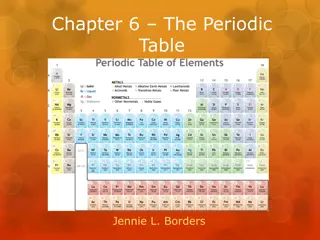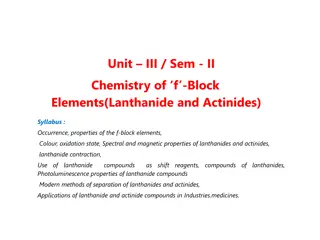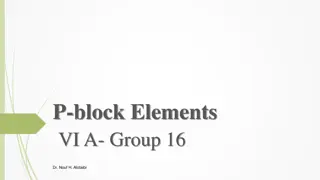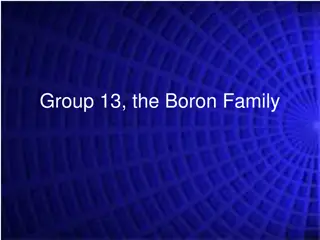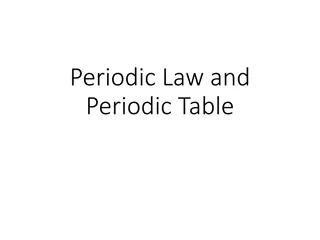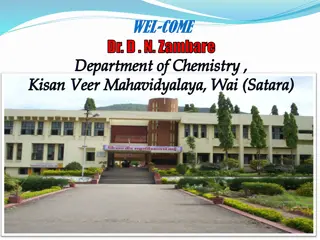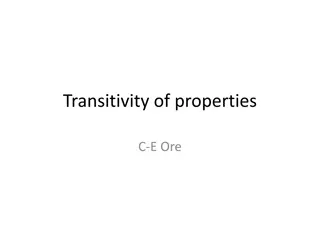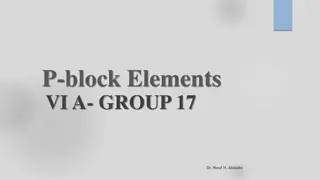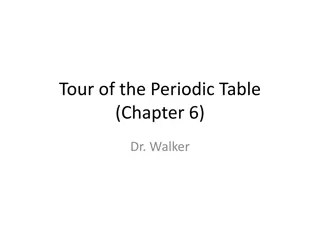Exploring Group 15 Elements: Properties and Trends
Dive into the characteristics of the group 15 elements: nitrogen, phosphorus, arsenic, antimony, bismuth, and moscovium. Discover their occurrence in nature, electronic configurations, atomic and physical properties trends, as well as chemical properties such as oxidation states and reactivity. Explore how these elements exhibit unique traits based on their position in the periodic table.
Download Presentation

Please find below an Image/Link to download the presentation.
The content on the website is provided AS IS for your information and personal use only. It may not be sold, licensed, or shared on other websites without obtaining consent from the author. Download presentation by click this link. If you encounter any issues during the download, it is possible that the publisher has removed the file from their server.
E N D
Presentation Transcript
ATOMIC ENERGY CENTRAL SCHOOL-3 MODULE-1 TOPIC-p-BLOCK ELEMENTS CHAPTER: 15 GROUP ELEMENTS
INTRODUCTION There are 6 elements in 15 group of periodic table i.e. Nitrogen, phosphorus, arsenic, antimony,bismuth & moscovium. These are called as p- block elements because the last electron enter in p- subshell of the atom of the element. Here nitrogen and phosphorus are non-metals, As and Sb are metalloids and Bismuth and moscovium (Mc) are typical metals.
Occurrence: Molecular nitrogen comprises 78% by volume of the atmosphere. In the earth s crust, it occurs as sodium nitrate, NaNO3 (called Chile saltpetre) and potassium nitrate (Indian saltpetre). It is found in the form of proteins in plants and animals. Phosphorus occurs in minerals of the apatite family. It is present in bones as well as in living cells. Phosphoproteins are present in milk and eggs. Arsenic, antimony and bismuth are found mainly as sulphide minerals. Moscovium is a synthetic radioactive element.
Electronic configuration General electronic configuration of 15 group elements : ns2npx1npy1npz1 Heres- subshell is completely filled and p- subshell is half filled is symmetric providing extra stability to the electronic configuration.
Trends in atomic & physical properties Atomic & ionic radii : Covalent and ionic (in a particular state) radii increase in down the group. There is a considerable increase in covalent radius from N to P. However, from As to Bi only a small increase in covalent radius is observed. This is due to the presence of completely filled d and/or f orbitals in heavier elements. Covalent radius (pm) N(70), P (110), As (121), Sb(141), Bi (148). Ionisation Enthalpy : Ionisation enthalpy decreases down the group due to gradual increase in atomic size. First ionization enthalpy of this group element is higher than group 14 and group 16 elements, due to stable electronic configuration.
Trends in physical properties Atomicity :All the elements of this group are polyatomic. Physical state: Dinitrogen is a diatomic gas while all others are solids. Metallic character increases down the group. Nitrogen and phosphorus are non-metals, arsenic and antimony metalloids and bismuth is a metal. This is due to decrease in ionisation enthalpy and increase in atomic size. The boiling points, in general, increase from top to bottom in the group but the melting point increases upto arsenic and then decreases upto bismuth. Allotropy : except nitrogen, all the elements show allotropy.
Trends in chemical properties Oxidation satates and reactivity : The common oxidation states of these elements are 3, +3 and +5. The tendency to exhibit 3 oxidation state decreases down the group due to increase in size and metallic character. In fact last member of the group, bismuth hardly forms any compound in 3 oxidation state. The stability of +5 oxidation state decreases down the group. The only well characterized Bi (V) compound is BiF5. The stability of +5 oxidation state decreases and that of +3 state increases (due to inert pair effect) down the group. Besides +5 oxidation state, nitrogen exhibits + 1, + 2, + 4 oxidation states also when it reacts with oxygen. However, it does not form compounds in +5 oxidation state with halogens as nitrogen does not have d-orbitals to accommodate electrons from other elements to form bonds.
Trends in chemical properties Oxidation states and reactivity : In the case of nitrogen, all oxidation states from +1 to +4 tend to disproportionate in acid solution. For example, 3HNO2-----> HNO3+ H2O + 2NO ( here +3 -----> +5 and +2) Similarly, in case of phosphorus nearly all intermediate oxidation states disproportionate into +5 and 3 both in alkali and acid. 4H3PO3--> 3H3PO4+ PH3 (here +3 -----> +5 and -3) However +3 oxidation state in case of arsenic, antimony and bismuth becomes increasingly stable with respect to disproportionation.
Trends in chemical properties All these elements form two types of oxides: E2O3 and E2O5. The oxide in the higher oxidation state of the element is more acidic than that of lower oxidation state. Their acidic character decreases down the group. The oxides of the type E2O3of nitrogen and phosphorus are purely acidic. Oxides of arsenic and antimony amphoteric and Oxides of bismuth predominantly basic. Reactions with oxygen
Trends in chemical properties Reaction with hydrogen All the elements of Group 15 form hydrides of the type EH3where E = N, P, As, Sb or Bi. The stability of hydrides decreases from NH3to BiH3which can be observed from their bond dissociation enthalpy. Consequently, the reducing character of the hydrides increases down the group. Ammonia is only a mild reducing agent while BiH3is the strongest reducing agent amongst all the hydrides. Basicity also decreases in the order NH3> PH3> AsH3> SbH3> BiH3. Due to high electronegativity and small size of nitrogen, NH3exhibits hydrogen bonding in solid as well as liquid state. Because of this, it has higher melting and boiling points than that of PH3.
Trends in chemical properties Reaction with halogens : These elements react to form two series of halides, EX3and EX5. Nitrogen does not form pentahalide due to non-availability of the d orbitals in its valence shell. Pentahalides are more covalent than trihalides. This is due to the fact that in pentahalides +5 oxidation state exists while in the case of trihalides +3 oxidation state exists. Since elements in +5 oxidation state will have more polarising power than in +3 oxidation state, the covalent character of bonds is more in pentahalides. All the trihalides of these elements except those of nitrogen are stable. In case of nitrogen, only NF3is known to be stable. Trihalides except BiF3are predominantly covalent in nature.
Trends in chemical properties Reaction with metals : All these elements react with metals to form their binary compounds exhibiting 3 oxidation state, such as, Ca3N2(calcium nitride) Ca3P2(calcium phosphide), Na3As (sodium arsenide), Zn3Sb2(zinc antimonide) and Mg3Bi2(magnesium bismuthide).
Properties of dinitrogen Dinitrogen is a colourless, odourless, tasteless and non- toxic gas. Nitrogen atom has two stable isotopes: 14N and 15N. It has a very low solubility in water (23.2 cm3 per litre of water at 273 K and 1 bar pressure) and low freezing and boiling points. Dinitrogen is rather inert at room temperature because of the high bond enthalpy of N, N three bonds.
Uses of dinitrogen The main use of dinitrogen is in the manufacture of ammonia and other industrial chemicals containing nitrogen, (e.g., calcium cyanamide). It also finds use where an inert atmosphere is required (e.g., in iron and steel industry,inert diluent for reactive chemicals). Liquid dinitrogen is used as a refrigerant to preserve biological materials, food items and in cryosurgery.
Compounds of Nitrogen Ammonia (NH3) Preparation of ammonia Haber s Process : On a large scale, ammonia is manufactured by Haber s process. N2(g) + 3H2(g) ----->2NH3(g); H0= 46.1 kJ mol 1 In accordance with Le Chatelier s principle, high pressure & low temperature would favour the formation of ammonia.
Preparation of ammonia Haber s Process
Properties of ammonia (NH3) Ammonia is a colourless gas with a pungent odour. Its freezing and boiling points are 198.4 and 239.7 K respectively. In the solid and liquid states, it is associated through hydrogen bonds as in the case of water and that accounts for its higher melting and boiling points than expected on the basis of its molecular mass. The ammonia molecule is trigonal pyramidal with the nitrogen atom at the apex. It has three bond pairs and one lone pair of electrons. Ammonia gas is highly soluble in water. Its aqueous solution is weakly basic due to the formation of OH ions. NH3(g) + H2O(l) ---> NH4+(aq) + OH (aq)
Nitric acid (Preparation) Ostwald s process : On a large scale nitric acid is prepared mainly by this method which is based upon catalytic(i.e. Pt/Rh) oxidation of NH3by atmosphericoxygen. 4NH3(g) + 5O2 (g) --- ----> 4NO (g) + 6H O (g) Nitric oxide thus formed combines with oxygen giving NO2. Nitrogen dioxide so formed, reacts with water to form nitric acid. 3NO2+ H2O(l) -----> 2HNO3(aq) + NO(g) NO thus formed is recycled and the aqueous HNO3can be concentrated by distillation upto ~ 68% by mass. Further concentration to 98% can be achieved by dehydration with concentrated H2SO4.
Nitric acid (Properties) It is a colourless liquid . In aqueous solution, nitric acid behaves as a strong acid. Concentrated nitric acid is a strong oxidising agent and attacks most metals except noble metals such as gold and platinum. Products of oxidation depend upon the concentration of the acid, temperature and the nature of the material undergoing oxidation. 3Cu + 8 HNO3(dilute) ----> 3Cu(NO3)2+ 2NO + 4H2O Cu + 4HNO3(conc.) -------> Cu(NO3)2+ 2NO2+ 2H2O 4Zn + 10HNO3(dilute) --->4 Zn (NO3)2+ 5H2O + N2O
Nitric acid (Properties) Some metals (e.g., Cr, Al) do not react with concentrated nitric acid because of the formation of a passive film of oxide on the surface. Concentrated nitric acid also oxidises non metals and their compounds. Iodine is oxidised to iodic acid, carbon to carbon dioxide, sulphur to H2SO4, and phosphorus to H3PO4. I2+ 10HNO3 --> 2HIO3+ 10NO2+ 4H2O C + 4HNO3---> CO2+ 2H2O + 4NO2 P4+ 20HNO3--> 4H3PO4+ 20NO2+ 4H2O
Oxides of nitrogen (Structures only) The binary compounds of nitrogen with oxygen are called as oxides of nitrogen. Nitrogen forms a number of oxides in different oxidation states(i.e. N2O, NO,NO2, N2O3, N2O5etc.) Where N2O is linear, NO2is angular and N2O3and N2O5are planar .
Phosphorus (allotropic forms) White Phosphorus Phosphorus is found in many allotropic forms, the important ones being white, red and black. White phosphorus is a translucent white waxy solid. It is poisonous, insoluble in water but soluble in carbon disulphide and glows in dark (chemiluminescence). It is less stable, more reactive than the other forms because of angular strain in P4molecule. It consists of discrete tetrahedral P4molecule.
Red phosphorus Red phosphorus is obtained by heating white phosphorus at 573K in an inert atmosphere for several days. Red phosphorus possesses iron grey lustre. It is odourless, nonpoisonous and insoluble in water as well as in carbon disulphide. Chemically, red phosphorus is much less reactive than whitephosphorus. It does not glow in the dark. It is polymeric, consisting of chains of P4tetrahedron.
Compounds of phosphorous (Phosphine) Introduction: It is basic hydride of phosphorus with molecular formula PH3, whichh is poisonous gas. Preparation : In the laboratory, it is prepared by heating white phosphorus with concentrated NaOH solution in an inert atmosphere of CO2. P4+ 3NaOH + 3H2O ---------> PH3+ 3 NaH2PO2 Properties : It is a colourless gas with rotten fish smell and is highly poisonous. It explodes in contact with traces of oxidising agents like HNO3, Cl2andBr2vapours. it is absorbed in HI to form phosphonium iodide (PH4I) it absorbed in copper sulphate or mercuric chloride solution, the corresponding phosphides are obtained. 3CuSO4+ 2PH3----> Cu3P2+ 3H2SO4 3HgCl2+ 2PH3--> Hg3P2+ 6HCl
Compounds of phosphorous (Phosphorus trichloride) Preparation : It is obtained by passing dry chlorine over heated white phosphorus or by the action of thionyl chloride with white phosphorus. P4+ 6Cl2-------> 4PCl3 P4+ 8SOCl2----> 4PCl3+ 4SO2+ 2S2Cl2 Properties :It is a colourless oily liquid and hydrolyses in the presence of moisture. PCl3+ 2H2O--->H3PO3+ 3HCl It reacts with organic compounds containing OH group such as CH3COOH, C2H5OH. 3CH3COOH + PCl3-----> 3CH3COCl + H3PO3 3C2H5OH + PCl3--> 3C2H5Cl + H3PO3 Structure : Central atom P is sp3hybridised,one lp on P atom, so that this molecule is pyramidal in shape.
Compounds of Phosphorus (Phosphorus pentachloride) Preparation : Phosphorus pentachloride is prepared by the reaction of white phosphorus with excess of dry chlorine or by the action of thionilcholoride (SO2Cl2) on white phosphorus. P4+10Cl2-----> 4PCl5 P4+ 10 SOCl2----> 4PCl5+ 10 SO2 Properties : Properties PCl5is a yellowish white powder and in moist air, it hydrolyses to POCl3and finally gets converted to phosphoric acid(H3PO3). PCl5+ H2O -----> POCl3+ 2HCl POCl3+ 3H2O --->H3PO4+ 3HCl When heated, it sublimes but decomposes on stronger heating. PCl5------> PCl3+ Cl2 It reacts with organic compounds containing OH group converting them to chloro derivatives. CH3COOH + PCl5---->CH3COCl + POCl3+HCl
Structure of PCl5 There are five P-Cl bonds in this structure, these are not equal. Three P-Cl bonds are equatorial bonds are equal but shorter than axial P-Cl bonds. Regular structure no lp on the P atom The shape & geometry of this molecule is trigonal bipyramidal. With bond length 202 pm (equatorial) and 240 pm (axial)
Oxoacids of Phosphorus Phosphorus forms a number of oxoacids. In oxoacids phosphorus is tetrahedrally surrounded by other atoms. All these acids contain at least one P=O bond and one P OH bond. The H atoms connected to O-atom are metal replaceable decide the basicity of acid. The H atom connected directly with P atom decide its reducing nature.





